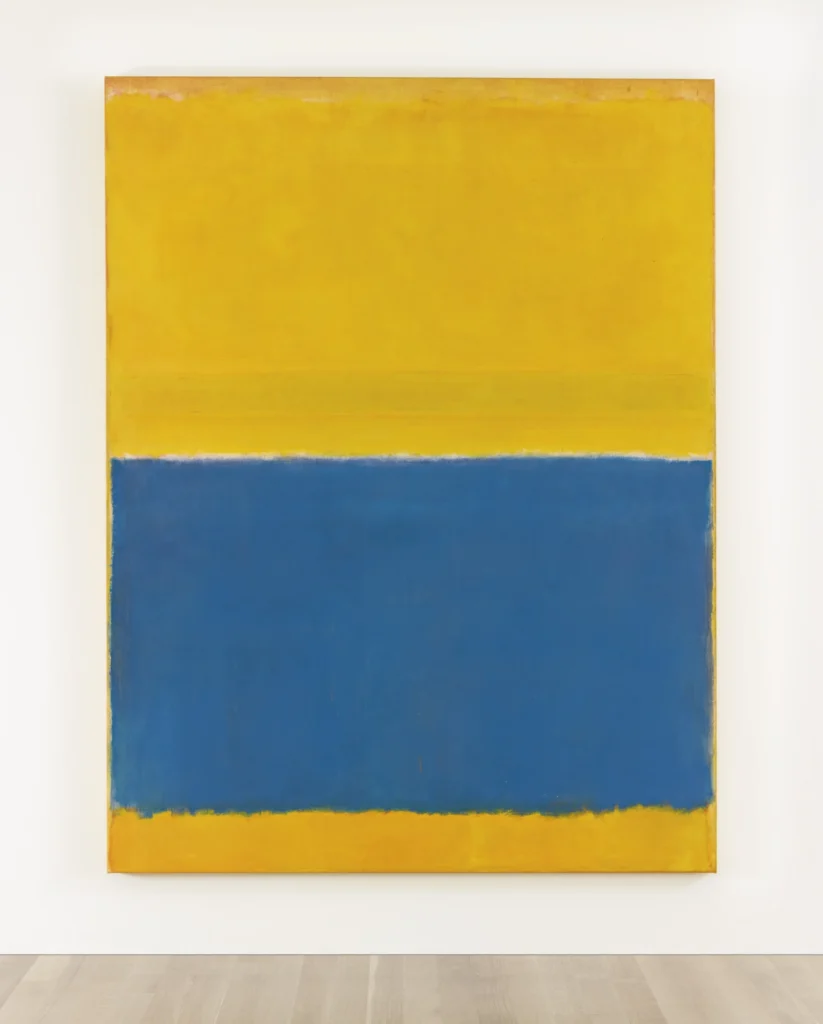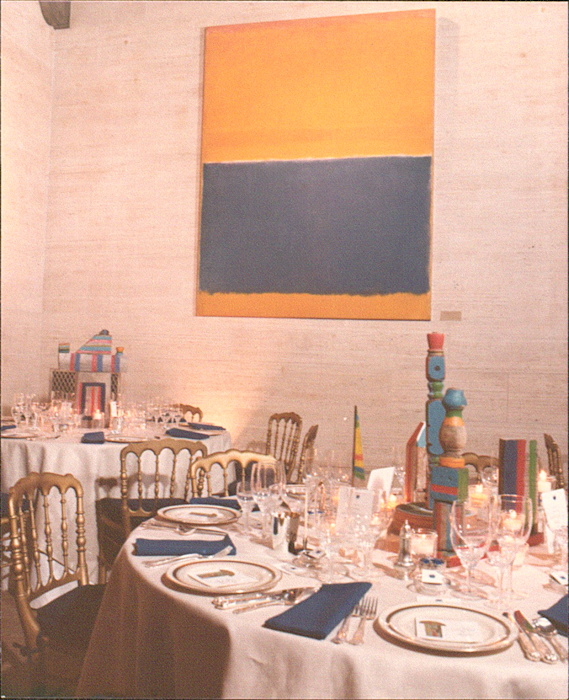
“As we stand enraptured by the stunning resplendency of Mark Rothko’s Untitled (Yellow and Blue) we bear witness to what can only be described as an unequivocal masterpiece of twentieth-century art history.”
I still contend that the auction catalogue essay is an underappreciated genre of art writing, and the 4,000-word lot essay for Sotheby’s 2015 sale of this prime Rothko feels worth a read. Especially so because Artnet reports that the auction house is selling the painting again this fall. And so we will have another essay with which we can index the way these classical Ab Ex artworks are positioned, and how their sellers, at least, imagine them to be understood.
In 2015 that meant namechecking everyone from Giotto to Niezstche and evoking the physical experience of standing in front of the painting in the most intense language you can muster. This manifestation is quoted after the jump, if you can handle it.
As for how the buyers understood things, we must piece together our own conclusions. Untitled (Yellow and Blue) is one of nine Rothko paintings Bunny and Paul Mellon acquired from Marlborough Gallery beginning in 1970, immediately after the artist’s death, and so right in the thick of the fiduciary malfeasance that prompted Rothko’s children to sue.
This and at least seven other Mellon Rothkos were promptly included in the National Gallery’s first show of modern art, in 1973.

Here it is, installed in the dinner organized by Bunny Mellon, above tables full of Betty Parsons sculptures, which were for sale.
Some time between Paul’s death in 1999 and 2006, when it was shown at the Palazzo Grassi, Bunny, by then in her nineties and rushing to spend several hundred million dollars before she died, sold the painting to François Pinault.
In June 2013, Pinault sold it through his auction house, Christie’s, along with a Fontana, to Eric Tan, a cutout for Jho Low, the Malaysian money launderer. [According to the Feds, the $79.5 million invoice was $36m for the Fontana, and so $43m for the Rothko.] In October 2013, Tan gifted the works, along with a $3 million Calder, to Low, with three copy & pasted “gift letters.”
[Because legal filings are another underappreciated genre of art writing, the excerpts of the gift letters included in the US Justice Dept’s 2020 forfeiture filing against other laundered artworks, a Warhol and a Monet, are also after the jump.]
In April 2014 Low borrowed $107 million from Sotheby’s Financial Services, pledging up to $285 million in artworks as collateral, including the Rothko, then he instructed them to sell artworks until the loan was repaid. Sotheby’s put the Rothko in their May 2015 Modern/Contemporary sale, where it was purchased by Russian oiligarch Farkhad Akhmedov for $46.5 million as part of his attempt to conceal $600 million while divorcing his wife Tatiana Akhmedova.
Tatiana was awarded title to the Rothko, other art, a yacht, and an apartment, in 2016, but some of the assets had been secretly transferred to the feuding couple’s son, and in 2020, she was still suing to receive them. When Sotheby’s publishes the updated provenance, perhaps we’ll know if Tatiana is the present seller. Artnet says the consignment was only just arranged, which may be why Sotheby’s pushed back their Hong Kong sale. But if you need to convert eight figures in a somewhat portable but rather traceable masterpiece, November 8 is your lucky day.
From Lot #11 in the catalogue for Sotheby’s Contemporary Art Evening Auction, May 2015:
“As we become fully subsumed within its luminous surface, our perception of physical boundaries or demarcations of material space dissolves and we are overcome by a sense of endless continuity, as if standing at a precipice reaching outwards toward an ever-receding, boundless horizon. Incandescent zones of brilliantly hued pigment, simultaneously distinct and inextricably intertwined, pulsate with a tangible energetic intensity that takes absolute hold of our vision, pulling us under in a wave of pure artistic bravura. An ocean of radiant lapis blue churns in the lower half of the composition, threatening to surge forth from its predetermined rectangular structure and pour into the shimmering fields of golden yellow that surround it. As witnesses to this inimitable masterwork, we are afforded the opportunity to travel through the subtle variants of tone and contour that comprise the intricate landscape of its surface, apprehending the subtly perceptible strokes of Rothko’s brush that imbue each area of Untitled (Yellow and Blue) with an ineffable breath and inexorable vivacity. Infused with an otherworldly glow, these iridescent tones harbor primal connotations of light, warmth, and the Sun; yet, in line with a perennial balance that characterizes the very archetypes of the artist’s corpus, there is a concurrent tension struck between the uplifting emotions conventionally evoked by warm golden hues and something implicitly more tragic. Inasmuch as the dazzling yellow, made endlessly dynamic by the sheer underlayers of red and blue pigment that give it an exquisite complexity, invokes the Sun it also implicates the inevitable cycle of dawn and dusk, of rise and set, of continual demise and rebirth. Rothko once stated to David Sylvester: ‘Often, towards nightfall, there’s a feeling in the air of mystery, threat, frustration – all of these at once. I would like my painting to have the quality of such moments.’ (the artist cited in David Anfam, Mark Rothko: The Works on Canvas: Catalogue Raisonné, New Haven and London, 1998, p. 88), and with its suggestion of an unobtainable horizon and an infinite, unbreakable cycle, this work harbors something that is indescribably portentous.”
From Document 1, Filed 07/01/20, in Case 2:20-cv-05916-DSF-PLA, UNITED STATES OF AMERICA, Plaintiff, v. ONE PAINTING ENTITLED “COLORED CAMPBELL’S SOUP CAN (EMERALD GREEN), 1965” BY ANDY WARHOL AND ONE PAINTING ENTITLED “VÉTHEUIL AU SOLEIL” BY CLAUDE MONET, Defendants: [I left the quotes as-is because honestly]
Each of these gift letters was: (a) dated October 2, 2013, (b) addressed to
LOW from TAN and Tanore, and (c) contained the subject line: “RE: GIFT OF ART-WORK(S) AS STATED BELOW IN CONSIDERATION OF YOUR FRIENDSHIP, YOUR CHARITABLE CONTRIBUTION TO THE WORLD, AND PASSION IN PROMOTING THE UNDERSTANDING AND APPRECIATION OF ART-WORKS.”
- Each letter included representations from TAN that he is the “sole 100% beneficial owner of TANORE FINANCE CORP,” and that he is “the legal and beneficial owner of all the art-work(s) mentioned in this gift letter.”
- The body of each letter also states:
“I wish to gift you ALL of the art-work(s) mentioned in this gift letter in consideration of the followings [sic]:
- all the generosity, support and trust that you have shared with me over the
course of our friendship, especially during the difficult periods of my life;
and - your continuous generosity in providing charitable contributions to
advance the well-being and development of our global communities; and - your passion in promoting the understanding and appreciation of art-
works.”
- Each gift letter closes by stating:
“All the art-work(s) gifted to you should not in any event be construed as an
act of corruption since this is against the Company and/or my principles and
I personally do not encourage such practices in any manner whatsoever.
The gift(s) is/are merely a token of appreciation and I am hoping that the
gift(s) to you would encourage you to continue with your good work
globally.”
[OCTOBER 2024 UPDATE] The essay for Sotheby’s upcoming Rothko sale in Hong Kong is out, and it is a banquet. After a pretty substantive amount of context-building and historical reference work on Rothko’s own view of his paintings as existential portals to an otherworldly sublime, they do not stint on the evocation itself. Here is just one taste:
“Through the seamless flow of color and light an atmosphere of the ethereal emanates as if from within Untitled (Yellow and Blue). As we become fully subsumed within its luminous surface, our perception of physical boundaries or demarcations of material space dissolves and we are overcome by a sense of endless continuity, as if standing at a precipice reaching outwards toward an ever-receding, boundless horizon. Incandescent zones of brilliantly hued pigment, simultaneously distinct and inextricably intertwined, pulsate with a tangible energetic intensity that takes absolute hold of our vision, pulling us under in a wave of pure artistic bravura. An ocean of radiant lapis blue churns in the lower half of the composition, threatening to surge forth from its predetermined rectangular structure and pour into the shimmering fields of golden yellow that surround it. As witnesses to this inimitable masterwork, we are afforded the opportunity to travel through the subtle variants of tone and contour that comprise the intricate landscape of its surface, apprehending the subtly perceptible strokes of Rothko’s brush that imbue each area of Untitled (Yellow and Blue) with an ineffable breath and inexorable vivacity. Infused with an otherworldly glow, these iridescent tones harbor primal connotations of light, warmth, and the Sun; yet, in line with a perennial balance that characterizes the very archetypes of the artist’s corpus, there is a concurrent tension struck between the uplifting emotions conventionally evoked by warm golden hues and something implicitly more tragic. Inasmuch as the dazzling yellow, made endlessly dynamic by the sheer underlayers of red and blue pigment that give it an exquisite complexity, invokes the Sun it also implicates the inevitable cycle of dawn and dusk, of rise and set, of continual demise and rebirth.”
Oh wow, and apparently I’m liveblogging my reading through the essay, and so I just saw that they’ve used the picture of the Rothko installed at Bunny Mellon’s NGA dinner party. I feel so proud. Is proud the right word?
[November 2024 update: and so it goes, for $HK252.5 million, or $US32.5 million, a 30% drop from its last known sale price. The South China Morning Post reported on the auction, which was a lowkey flop, by noting that this Rothko “went viral” in 2022 because of its resemblance to the Ukrainian flag, without noting its resemblance to their own logo.]

